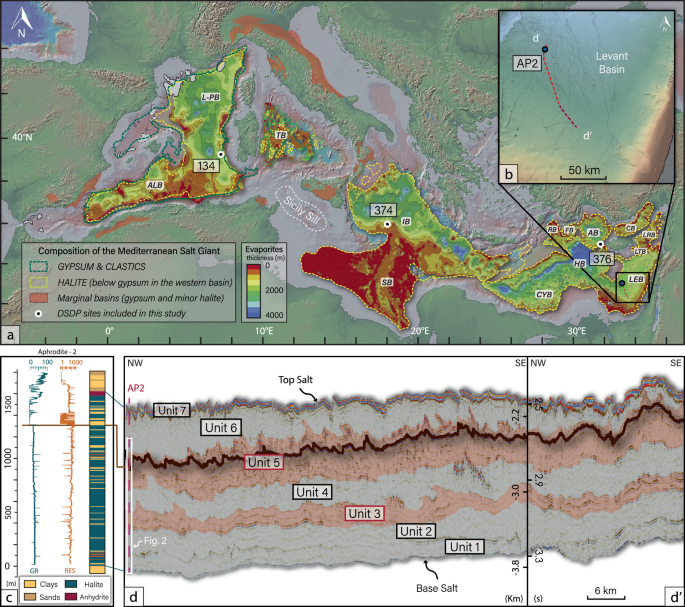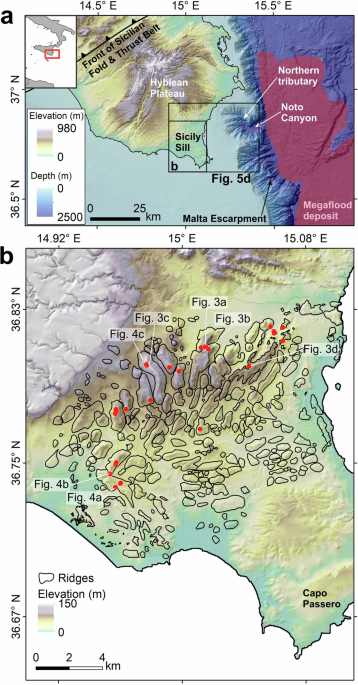I write below some simplified context for this fresh publication in @ScienceAdvances that hopefully provides a satisfactory explanation.
Something that makes the Mediterranean a very peculiar sea is a brief period of 630,000 yrs during which it became isolated from the ocean. The dry weather made most of its waters evaporate and caused one of the largest and best documented environmental crises in Earth’s history.
Geoscientists refer to it as the Messinian Salinity Crisis (MSC).
In a recent research we found that at least 89% of the marine life of the Mediterranean Sea went extinct due to these events. Unlike for global extinction events, this one happened in geologically-recent times, a mere 5 to 6 million years ago,
when the Mediterranean Sea had already a similar geographical configuration trapped between Africa and Europe as today, restrained from the Ocean circulation.
The widespread presence of a 1 to 4 kilometer-thick layer of salt under much of the seafloor tells that this isolated Mediterranean became a huge salt pan starting 5.97 million years ago.
The finding of erosion valleys carved at the margins of the basin and the isotopic signature measured in the salt’s chloride, both point to an unprecedented sea level drop in excess of one kilometer.
The relative dry climate of the region would be responsible for such rapid evaporation, leading to the accumulation of salt in less than 50 thousand years and leaving most of the seafloor exposed to the atmosphere.
If all this does not collide with your intuition of the slow timescales of landscape and environmental changes, wait to know how these events may have ended. A 200 meter deep erosion canyon found across the Strait of Gibraltar, together with elongated erosion patterns excavated
in southern Sicily and several sediment formations deposited just before the restoration of normal conditions in the Mediterranean Sea,
CC @MicallefAaron
CC @MicallefAaron
all strongly suggest that this hypersaline period ended very fast, possibly in an unprecedented megaflood of cataclysmic proportions that refilled the sea with Atlantic waters, perhaps in less than two years.
Yet, a last-standing question about this period has been puzzling Earth scientists alike for decades: what happened during the 300 thousand years between the salt accumulation and the reflooding?
This last stage is known as "Lago-Mare".
This last stage is known as "Lago-Mare".
Shellfish fossils of the family of ostracods found in deep-sea ocean drillings demonstrate that the abyssal areas of the Mediterranean were occupied by shallow lakes, consistent with the idea of a nearly complete desiccation.
However, similar fossils are also found in many places near today’s coastline in Spain or Greece, close or even above the present sea level. Hence, the Mediterranean sea appears to be both empty and full during that period after salt precipitation and before the reflooding.
Furthermore, observed erosion marks presumably formed along the Mediterranean coast (these are today buried under water and under 5 million years of sedimentation),
provide divergent estimations of the sea-level drop, covering the entire range from a nearly desiccated basin to a nearly full one. So, how much did the level of the Mediterranean drop, for how long, and what was controlling that level?
One thing that soon became clear to paleontologists is that those ostracods where newcomers from beyond the Mediterranean. Their presence proofs that, during the desiccation, the excess waters from the Black Sea and beyond drained towards the south west and colonized the entire
Mediterranean, perhaps aided by the lack of competitors caused by the previous salinization.
In the new study linked above, we investigate this question using a numerical model of landscape evolution constrained with estimations of rainfall and sedimentation during those events.
In the new study linked above, we investigate this question using a numerical model of landscape evolution constrained with estimations of rainfall and sedimentation during those events.
The results show that the erosion along the spillways of the Black Sea and other lakes towards the lowered Mediterranean Sea caused a level drop in the former and an amplified level rise in the latter.
Erosion of the bedrock under these fluvial connections caused the Black Sea and other neighboring lakes to decrease in level and surface area, reducing their evaporation and increasing the amount of water delivered to the desiccated Mediterranean Sea.
This can explain the Schoedingerian puzzle about the simultaneous emptiness and fullness of the Mediterranean.
One objection to this mechanism is that it suggests a maximum level at the end of the Mediterranean isolation, right before its presumed cataclysmic terminal flooding. But here is where the natural climate changes provide a solution:
Average rainfall is known to change proportionally to the insolation of the northern hemisphere, following changes of the Earth’s orbit. This causes substantial oscillations in average rain over periods of a few tens of thousands of years.
The low insolation and rainfall that
The low insolation and rainfall that
prevailed 5.33 million years ago, when the Atlantic Ocean poured its water in, predicts a low Mediterranean level that is consistent with the triggering of the final Zanclean Megaflood.
After a few decades of discovery and research, the pieces of the MSC seem to come together.
After a few decades of discovery and research, the pieces of the MSC seem to come together.
And they show a scenario of very rapid landscape and environmental episodes during Earth's history that have been so far largely neglected.


